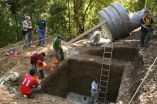While the findings are reason for great optimism, researchers say it is now important to understand the factors that could influence the public's willingness to use the drug in this way, known as pre-exposure prophylaxis, or PrEP.
Scientists, health authorities and policymakers are currently debating the pros and cons of PrEP in the U.S. and around the world. One significant issue is these medications' high cost, which often makes them inaccessible to those already infected, let alone those who wish to use them as a prevention tool. Another major question: What would potential users of PrEP expect from such a pill if it were to be made widely accessible?
In a study published recently in the International Journal of STD & AIDS, a team of researchers from UCLA and Lima, Peru, offers a starting point for assessing the public's willingness to consider PrEP.
The researchers used consumer marketing techniques to gauge acceptance of the therapy among high-risk groups in Lima. They found that study participants were generally supportive of PrEP but that out-of-pocket costs had the greatest impact — even more than the drug's effectiveness — on their willingness to use it.
Participants also reported that they would expect the pill to be 100 percent effective and to be taken only prior to having sex. These responses are particularly important, given that the actual PrEP study data was based on a pill that needed to be taken daily regardless of sexual activity and whose efficacy was much lower than 100 percent. This indicates that consumers may be overly optimistic about PrEP, the researchers said.
"Just a few months ago, we learned that PrEP can prevent HIV infection, but it has not been deployed on a large scale yet and is a topic of debate in the HIV-prevention research community," said Jerome Galea, Latin America regional director for the UCLA Program in Global Health and one of the study's co-investigators. "Our study is important to the public because it used two separate methods — focus groups and 'conjoint analysis' — to examine the acceptability of this approach among potential users and considered an array of characteristics that could influence the actual real-world applicability of its use."
The use of conjoint analysis was unique in this instance; the technique is generally used to assess consumers' purchasing choices by asking them to choose between products that are slightly different but do the same thing.
"This is the first study of its kind to apply this specific market research technique to understand what the 'consumers' of PrEP valued most about this method of prevention," Galea said.
For the study, the researchers divided 45 participants — including female sex workers, male-to-female transgendered persons and men who have sex with men (MSM) — into seven groups of four to eight individuals, with each participating in both the focus groups and the conjoint analysis exercise.
In the focus groups, participants discussed social issues associated with PrEP, including their knowledge and understanding of it and their peers' attitudes toward it. It was in these groups that participants expressed their wish for 100 percent effectiveness. The conversations were recorded, transcribed and analyzed for emergent themes.
In the conjoint analysis portion of the study, participants were asked to rate hypothetical scenarios, allowing the researchers to measure seven PrEP attributes, with two choices for each of those attributes. The scenarios were:
Monthly out-of-pocket costs ($10 vs. $250) Efficacy (75 percent vs. 95 percent) Side effects (none vs. nausea and dizziness) Duration of use (one year vs. 10 years) Dosing frequency (before sex vs. every day) Dispensing venue (general clinic vs. HIV clinic) Person dispensing the pill (pharmacist vs. doctor or nurse)
Participants were asked to rate the choices in these scenarios on a five-point scale ranging from "definitely would accept" to "definitely would not accept." The researchers then converted their responses to a 100-point scale.
The conjoint analysis revealed that a low out-of-pocket cost was the most important factor to the participants.
"While we expected cost to be an important factor, we were surprised that it was more important than the ability of the product to actually prevent HIV infection," Galea said.
In the conjoint analysis exercise, the preferred scenario was a pill that cost $10 per month; had 95 percent efficacy; had no side effects; would be administered for 10 years; could be taken just before having sex; and would be dispensed by a doctor or nurse at an HIV clinic.
The focus groups' data supported the importance of low cost but also revealed concerns over sexual risk disinhibition, the potential stigma associated with PrEP use and mistrust of health care professionals.
Study limitations include the possibility that some subjects may have participated more than others and their views may have been overrepresented as a result; the sample size and researchers' choice of participants may not make these findings applicable to other groups; and the scenarios chosen may not reflect all possible characteristics.
This research, Galea said, should be extended to other at-risk populations in different settings.
"We cannot generalize our findings to all persons at risk for HIV, in Peru or elsewhere," he said. "But we do propose it as a model for future exploration of the topic, now that oral PrEP has been shown to work but has not yet been scaled up for widespread use."
INFORMATION:
The National Center on Minority Health and Health Disparities, the National Institute on Aging, the UCLA/Drew Project Export and the UCLA/Drew Center for Health Improvement of Minority Elderly/Resource Center for Minority Aging Research funded this study.
Study co-authors are Janni J. Kinsler, Sung-Jae Lee, Jennifer N. Sayles and William E. Cunningham, all of UCLA, and Carlos Cáceres, Ximena Salazar and Maziel Giron of Cayetano Heredia University in Lima, Peru.
For more news, visit the UCLA Newsroom and UCLA News|Week and follow us on Twitter.
END

